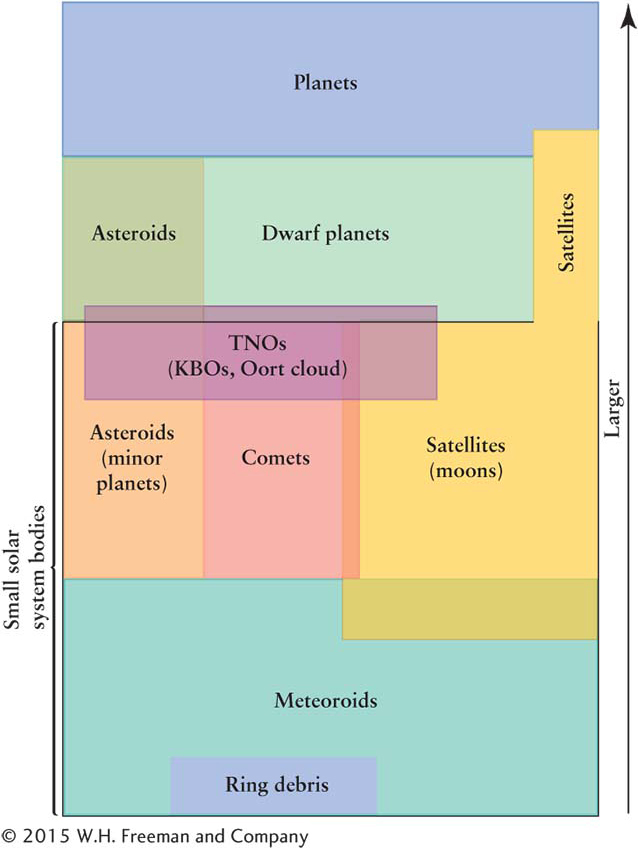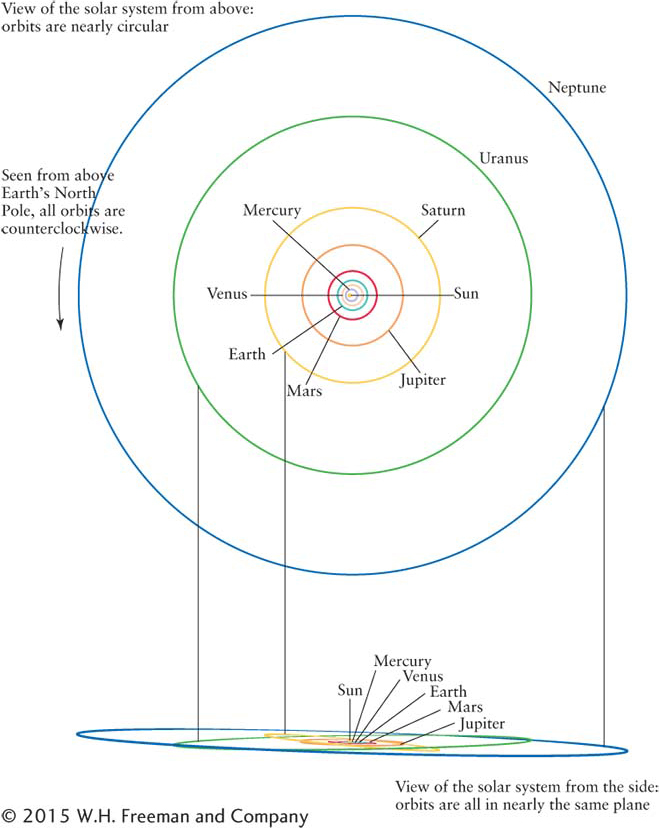CATEGORIES OF THE PRESENT-DAY SOLAR SYSTEM
4-8 The categories of solar system objects have evolved
While it makes sense that the objects in the asteroid belt are called asteroids, the naming of bodies there and throughout the solar system is more complicated than that. Traditionally, an asteroid is a piece of space debris composed primarily of rock and metal that is larger than about 10 m (no exact minimum size has been agreed upon). Space debris smaller than this and composed primarily of rock and metal are called meteoroids. All debris that is a roughly equal mix of ice and rock are called comets. More precisely, the solid body of ice and rock that exists even when a comet has no tail is called a comet nucleus. The asteroid belt contains all three types of debris. Indeed, all the remaining planetesimals have become today’s asteroids, meteoroids, and comets.
Focus Question 4-5
How might some of the meteoroids in the solar system come from asteroids?
Another layer of terminology about bodies orbiting the Sun (and, by inference, any other stars) was introduced in 2006, when the International Astronomical Union redefined the term planet. According to the most recently accepted definition, a planet is a celestial body that (1) orbits the Sun or another star; (2) has enough mass so that its own gravitational attraction causes it to be essentially spherical, rather than being a large, irregular rock in space; and (3) has enough gravitational attraction to clear its neighborhood of other orbiting debris. Planets “clear their neighborhoods” by either pulling surrounding debris onto themselves or, in some cases, flinging debris far away from their orbits. There are thus eight planets in the solar system: Mercury, Venus, Earth, Mars, Jupiter, Saturn, Uranus, and Neptune.

A dwarf planet satisfies conditions (1) and (2) but not condition (3). These objects are smaller than planets with less mass and, hence, less gravitational attraction. This definition is the reason that Pluto was demoted from planet status. So far, of the myriad candidate bodies, astronomers have agreed on five dwarf planets: Pluto, Ceres, Haumea, Makemake (pronounced mah-
A moon or natural satellite is an object orbiting a larger body that is, in turn, orbiting the Sun or another star. Rings of billions of dust particles and mountain-
Everything in the solar system that is not a planet, dwarf planet, moon, or part of a ring system, is called a small solar system body (SSSB). The tricky part is that the largest asteroids are dwarf planets, whereas the vast majority of asteroids, as well as all meteoroids and all comets, are small solar system bodies. Figure 4-9 summarizes these relationships.
109
4-9 The orbits of the planets are related
Because the planets formed in a disk, they should all orbit in more or less the same plane as Earth (that is, nearly in the plane of the ecliptic). Observations bear out this conclusion. The angles of the orbital planes of the other planets with respect to the ecliptic are called their orbital inclinations, and all are 7° or less (Figure 4-10).

Furthermore, according to the Nice model, all of the planets formed from the same swirling cloud of gas and dust, and hence they should all orbit the Sun in the same direction, which they do. Moreover, since the Sun was formed from the same swirling gas and dust as the planets and other members of the solar system, it should be rotating, and the planets should be orbiting in the same direction as the Sun rotates. Imagine traveling far above Earth’s North Pole and looking down at the Sun and planets. You would see the Sun rotating counterclockwise and all the planets orbiting counterclockwise, consistent with the Nice model of how the solar system formed.
 To find out more about the solar system’s origins, astronomers study the leftover interplanetary debris: asteroids, meteoroids, and comets. Many of these bodies are thought to be virtually unchanged remnants of the solar system’s formation. According to radioactive dating of the oldest debris ever discovered from space (see Appendix Q: Radioactivity and the Ages of Objects), the solar system was roughly in the form we know today just under 4.6 billion years ago. As we will see throughout the book, a lot happened between the formation of the universe some 13.8 billion years ago and the formation of the solar system, some 9 billion years later.
To find out more about the solar system’s origins, astronomers study the leftover interplanetary debris: asteroids, meteoroids, and comets. Many of these bodies are thought to be virtually unchanged remnants of the solar system’s formation. According to radioactive dating of the oldest debris ever discovered from space (see Appendix Q: Radioactivity and the Ages of Objects), the solar system was roughly in the form we know today just under 4.6 billion years ago. As we will see throughout the book, a lot happened between the formation of the universe some 13.8 billion years ago and the formation of the solar system, some 9 billion years later.
110
On the young Earth, one of the conditions that allowed for the beginning of biological evolution was the presence of liquid water. Strong evidence indicates that liquid water existed on Mars and may still exist inside it and inside Jupiter’s moons Europa and Ganymede, as well as Saturn’s moons Titan and Enceladus, raising the hotly debated question of whether simple life has evolved on those worlds as well.
4-10 The Sun developed while the planets matured
During the 100 million years that the inner planets were completing their formation, the protosun was also evolving. Throughout this time, the temperature and pressure at the center of the slowly contracting protosun continued to increase. Finally, its core reached about 107 K, which is hot enough to initiate hydrogen fusion, in which hydrogen is converted into helium. Such fusion generates energy in the form of gamma rays, which, slamming into the gases in the protosun, created enough pressure inside the protosun to stabilize it, here meaning preventing it from expanding or contracting. At that point, the Sun became a star. As noted earlier, some of the energy generated in the Sun’s core leaks out, which is why the Sun shines. Hydrogen fusion continues in the Sun’s core today and the energy generated there over the past 4.5 billion years has maintained the Sun’s size and temperature, and thereby enabled Earth to sustain life.
Sunlike stars take approximately 100 million years to form from a nebula and settle down, which means that the Sun probably became a full-